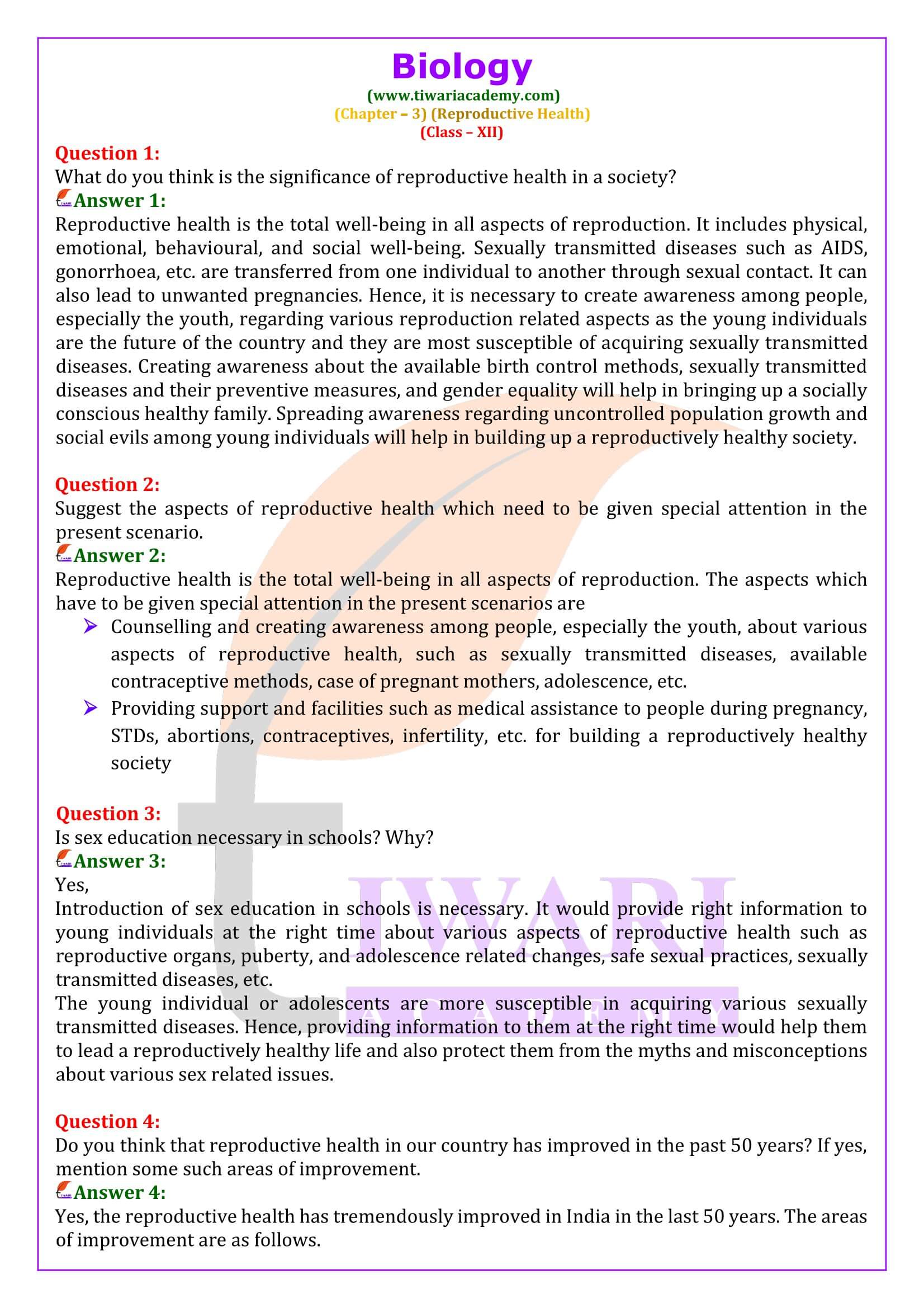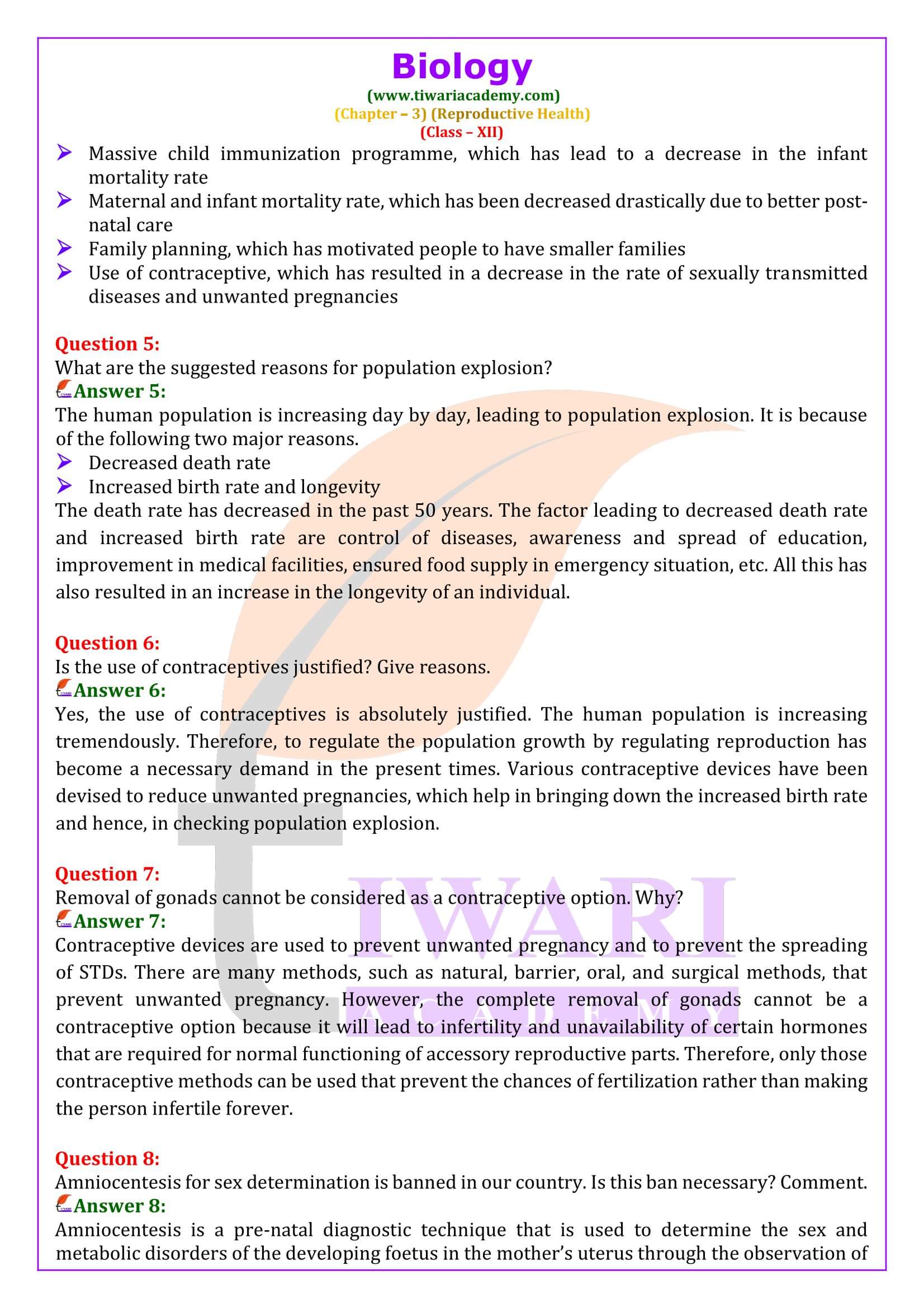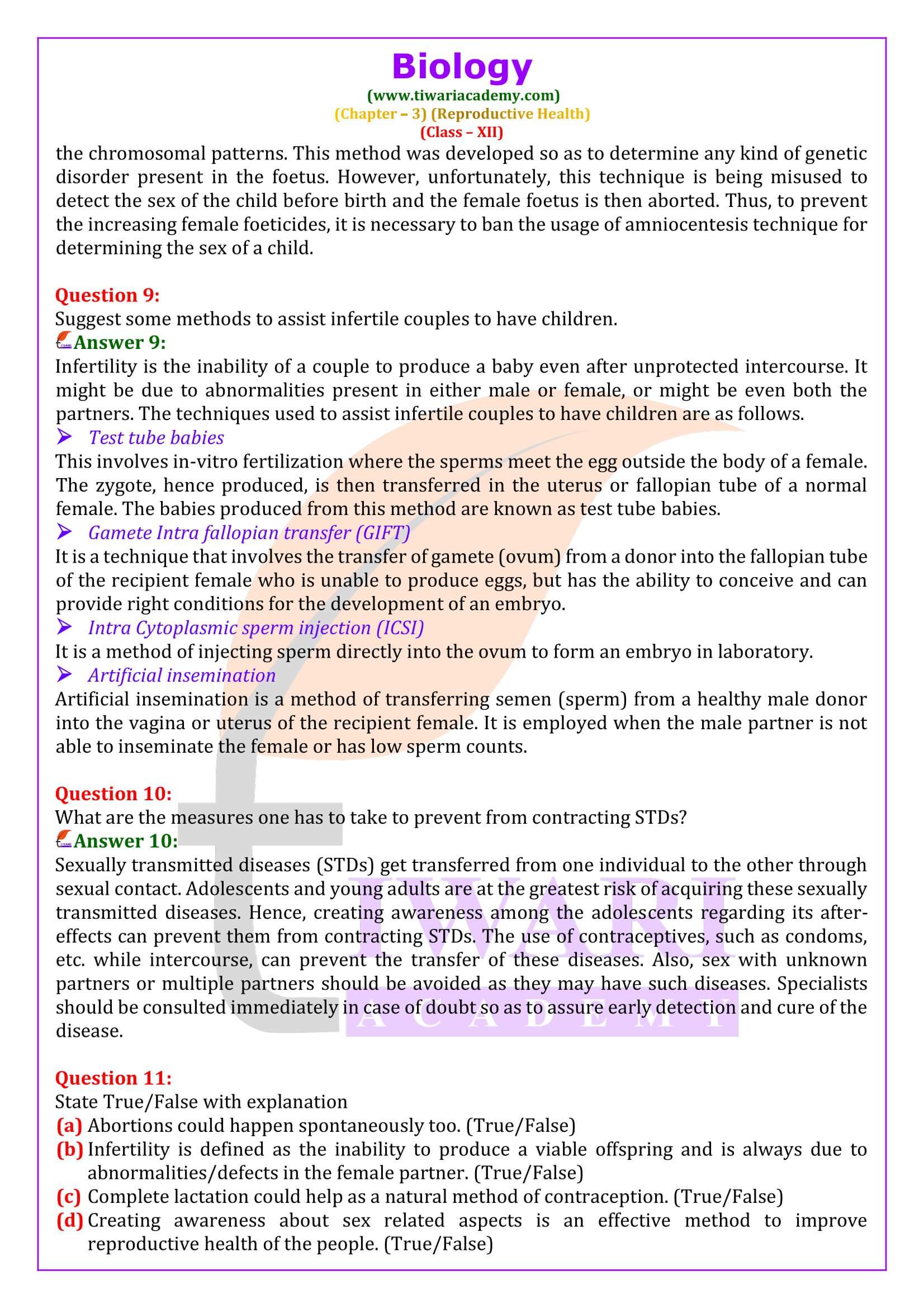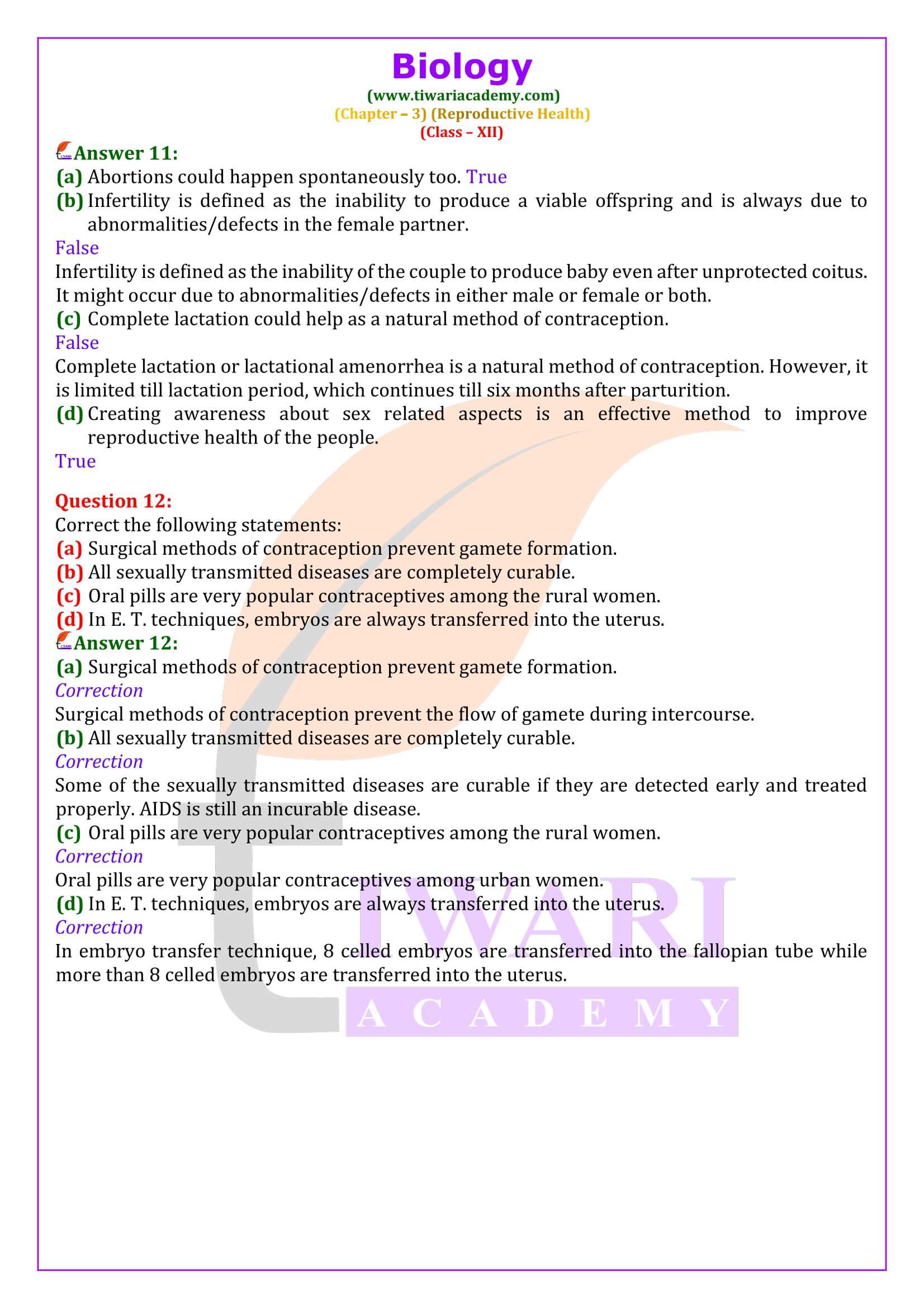NCERT Solutions for Class 12 Biology Chapter 3 Reproductive Health in Hindi and English Medium PDF file format free download or Study Online without downloading it updated for new academic session 2024-25. NCERT Solutions for other subjects based on latest CBSE Syllabus also available to download. Ask Your Questions through Discussion Forum are reply to your friends.
NCERT Solutions for Class 12 Biology Chapter 3
| Class: 12 | Science |
| Subject: | Biology |
| Chapter 3: | Reproductive Health |
| Content Type: | Images, PDF, Text and Videos |
| Academic Year: | Session 2024-25 |
| Medium: | Hindi and English Medium |
Class 12 Biology Chapter 3 Solutions in English
NCERT Solutions for Class 12 Biology Chapter 3 Reproductive Health is given here to download in PDF format free or use online updated for new academic session 2024-25. These solutions are applicable for UP Board, Gujrat Board, CBSE Board, MP Board and all other boards who are following latest CBSE Syllabus.
Extra Questions Class 12 Biology Chapter 3
Give the term for rapid population growth.
Population explosion.
Name the Fluid from which foetal cells are extracted for chromosomal analysis.
Amniotic fluid.
Mention the various precautions one has to take in order to protect himself/ herself form STDs.
(i) Avoid blood transfusion from an infected person.
(ii) Avoid sex with an unknown partner and multiple partners.
(iii) Always use condom.
(iv) Avoid sharing of injections needles and syringes and surgical instruments.
Methods of Birth Control
1. Natural Methods: Periodic abstinence, Coitus interruptus or withdrawal Lactational amenorrhea.
2. Barrier Methods: Condom, Diaphragms, Cervical cap and vault
3. Intra Uterine Devices: Nonmedicated (e.g. Lippes loop), Copper releasing (e.g., Cu-T, multiload 375), Hormone releasing (e.g. LNG-20, progestasert)
4. Oral contraceptives: Pills / Saheli, Mala-D Small doses of either progestogens or Progestogen-estrogen combination.
5. Injections: Progestrone derivates given every three months.
6. Implants: Synthetic progestrone patches are implanted under the skin. Prevents pregnancy upto 4 years.
6. Emergency pills: Must be taken within 72 hours of coitus. They have high concentration of progestrone and oestrogen which prevent ovulation, e.g. I pill, unwanted-72 etc.
7. Surgical (Sterilisation): (1) Tubectomy; (2) Vasectomy in male in females.
Important Questions for practice
Questions:
1. Give the term for prenatal diagnostic technique aimed to know the sex of developing foetus and to detect congenital disorders.
2. After a successful in-vitro fertilisation, the fertilised egg begins to divide. Where is this egg transferred before it reaches the 8-celled stage and what is this technique called?
3. Give another name for sexually transmitted diseases. Name two sexually transmitted diseases which are curable and two diseases which are not curable.
Answers:
1. Amniocentesis.
2. Fallopian tube; Zygote intra fallopian transfer (ZIFT)
3. Veneral disease (VD)/Reproductive tract infection (RTI), Curable-Syphilis, Gonorrhoea, Non Curable-Hepatitis B, AIDS.
What are the measures one has to take to prevent from contracting STDs?
Sexually transmitted diseases (STDs) get transferred from one individual to the other through sexual contact. Adolescents and young adults are at the greatest risk of acquiring these sexually transmitted diseases. Hence, creating awareness among the adolescents regarding its after-effects can prevent them from contracting STDs. The use of contraceptives, such as condoms, etc. while intercourse, can prevent the transfer of these diseases. Also, sex with unknown partners or multiple partners should be avoided as they may have such diseases. Specialists should be consulted immediately in case of doubt so as to assure early detection and cure of the disease.
Important Questions on 12th Biology Chapter 3
Is sex education necessary in schools? Why?
Introduction of sex education in schools is necessary. It would provide right information to young individuals at the right time about various aspects of reproductive health such as reproductive organs, puberty, and adolescence related changes, safe sexual practices, sexually transmitted diseases, etc. The young individual or adolescents are more susceptible in acquiring various sexually transmitted diseases. Hence, providing information to them at the right time would help them to lead a reproductively healthy life and also protect them from the myths and misconceptions about various sex related issues.
What are the suggested reasons for population explosion?
The human population is increasing day by day, leading to population explosion. It is because of the following two major reasons. Decreased death rate Increased birth rate and longevity The death rate has decreased in the past 50 years. The factor leading to decreased death rate and increased birth rate are control of diseases, awareness and spread of education, improvement in medical facilities, ensured food supply in emergency situation, etc. All this has also resulted in an increase in the longevity of an individual.
Removal of gonads cannot be considered as a contraceptive option. Why?
Contraceptive devices are used to prevent unwanted pregnancy and to prevent the spreading of STDs. There are many methods, such as natural, barrier, oral, and surgical methods, that prevent unwanted pregnancy. However, the complete removal of gonads cannot be a contraceptive option because it will lead to infertility and unavailability of certain hormones that are required for normal functioning of accessory reproductive parts. Therefore, only those contraceptive methods can be used that prevent the chances of fertilization rather than making the person infertile forever.
Suggest some methods to assist infertile couples to have children.
Infertility is the inability of a couple to produce a baby even after unprotected intercourse. It might be due to abnormalities present in either male or female, or might be even both the partners. The techniques used to assist infertile couples to have children are as follows. Test tube babies This involves in-vitro fertilization where the sperms meet the egg outside the body of a female. The zygote, hence produced, is then transferred in the uterus or fallopian tube of a normal female. The babies produced from this method are known as test tube babies. Gamete Intra fallopian transfer (GIFT) It is a technique that involves the transfer of gamete (ovum) from a donor into the fallopian tube of the recipient female who is unable to produce eggs, but has the ability to conceive and can provide right conditions for the development of an embryo. Intra Cytoplasmic sperm injection (ICSI) It is a method of injecting sperm directly into the ovum to form an embryo in laboratory. Artificial insemination Artificial insemination is a method of transferring semen (sperm) from a healthy male donor into the vagina or uterus of the recipient female. It is employed when the male partner is not able to inseminate the female or has low sperm counts.








